5 Omnichannel Metrics Marketers Must Measure for Success

Interacting with customers requires meeting them where they're at.
But with the average consumer accessing multiple platforms a day, it's only a matter of time before inconsistencies happen. This, coupled with the challenges of working with other departments in a cross-functional setting, can lead to friction in a customer's journey.
That's why it's crucial for brands to implement an omnichannel strategy. By interconnecting channels with each other, you create an experience that’s not only seamless but also personalized for every individual customer.
If you're planning to fully integrate your omnichannel efforts, you’re in the right place.
This guide recommends five omnichannel metrics to align your marketing, sales, and customer success departments. By tracking them, you ensure your messages are as consistent and personally relevant as possible across multiple touchpoints.
Skip ahead:
- What is Omnichannel Marketing?
- Top 5 Omnichannel Metrics & KPIs to Track Your Progress
- How to Implement Omnichannel Reporting
- How to Create an Omnichannel Report Automatically
- Automate Your Omnichannel Reporting on DashThis Today!
What is Omnichannel Marketing?
Omnichannel marketing integrates all your channels, devices, and customer-centric departments to create a consistently hyper-personalized experience across all stages.
Here's an example to show you what we mean:
A fashion eCommerce store sends a welcome email to new customers. For customers who leave a product in the cart, it offers a 15% discount code via SMS. After customers complete the purchase, it sends a follow-up SMS offering another discount code for both in-store and online. When clicked, the URL link takes shoppers directly to a personalized page (tailored to the customer’s size and past purchases) in its mobile app.
Top 5 Omnichannel Metrics & KPIs to Track Your Progress
Setting up a fully integrated omnichannel strategy requires cross-functional collaboration across customer-focused departments. Here are five shared KPIs to align marketing, sales, and customer support.
Customer lifetime value (CLV)
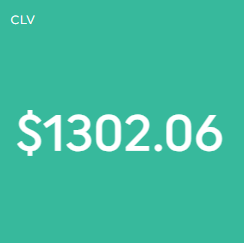
Customer lifetime value (CLV) is the total worth of a customer over the course of their relationship with your business.
WHY IS IT IMPORTANT:
Determine the true value of your customers. That way, you can plan your strategic and operational decisions accordingly. CLV (or CLTV) is often measured alongside customer acquisition cost (CAC) and retention rate.
HOW TO CALCULATE IT:
Customer value X Average customer lifespan
Conversion rate (CVR)
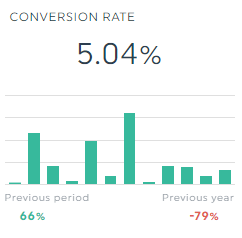
Conversion rate (CVR) is the percentage of users who completed a high-value action on your website.
WHY IS IT IMPORTANT:
CVR is an outcome-based metric. It tells you if your marketing campaigns are compelling your target audience to take action on your site.
Monitor your CVR across different channels to identify the top-performers (and overall to gauge your omnichannel marketing strategy as a whole).
For channels that show high CVR, allocate more resources to maximize returns.
Unfortunately, it's a lot more complicated for channels with low CVR—the culprits could be anywhere from mismatched traffic sources to slow load time. Track other metrics like click-through rate (CTR) and bounce rate to gain a complete picture.
HOW TO CALCULATE IT:
(Number of conversions / Number of visits) x 100
Customer retention rate (CRR)

Customer retention rate (CRR) is the percentage of customers that stay with your business. Measure this metric alongside churn rate to better understand your profitability.
WHY IS IT IMPORTANT:
Acquiring a new customer is five to 25 times more expensive than retaining an existing one. Avoid falling into the "acquisition trap" and start investing in retention initiatives. You'll stand a better chance at achieving sustainable growth and healthy profits.
HOW TO CALCULATE IT:
[(Number of new customers at the end of a given period - Number of new customers acquired during that given period) / Number of customers when the period began] x 100
Net Promoter Score (NPS)

Net promoter score (NPS) is a customer loyalty benchmark that measures how likely customers will recommend your business to a friend. It's measured from a scale from -100 to 100.
WHY IS IT IMPORTANT:
High customer satisfaction score correlates with revenue growth, according to Bain & Company.
Companies with excellent customer experience grow revenues 4%-8% above their market, thanks to the "stronger loyalty among customers, turning them into promoters who tend to buy more, stay longer and make recommendations to their friends."
HOW TO CALCULATE IT:
Percentage of promoters - Percentage of detractors
Average Order Value (AOV)
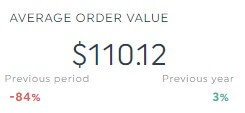
Average order value (AOV) is the average amount of money customers spend per transaction on your website or app.
WHY IS IT IMPORTANT:
Understand customer behavior. That way, you can identify opportunities to increase revenue and profitability, like bundling your products, cross-selling relevant add-ons, or creating an order minimum for free shipping.
HOW TO CALCULATE IT:
Total revenue / Total number of orders placed
How to Implement Omnichannel Reporting
If you haven’t fully integrated your omnichannel marketing efforts, you're likely experiencing siloed information and disconnected experiences. Here's what we recommend ensuring you create a hyper-consistent experience across all stages.
1. Consolidate your data
The first step to implementing omnichannel reporting is to pick a centralized database.
That way, everyone gets a holistic view of all customer interactions with the company—marketing, sales, and customer support can track the channels, marketing campaigns, and conversations in one place.
The ideal database will depend on a myriad of factors, including your chosen channels and the amount of data available.
For example, a modest sized eCommerce store that engages with customers via email, phone, SMS, and social media will find a CRM suffice.
On the other hand, an enterprise app will require a much more sophisticated solution. Suppose it wants to track campaigns across influencers, owned media, and paid media partners in its omnichannel marketing.
It needs to connect all platforms via API and run its exports on a schedule. Moving forward, it will likely conduct data cleaning (using tools like HubSpot’s Operations Hub) to ensure its customer data is up-to-date and accurate for the business.
If this strategy is far too complex for your needs, consider using DashThis.
It's the easiest reporting tool that gathers data across your favorite marketing channels into one beautiful report, automatically.

Grab this free social media report template with your own data!
Features include:
- All-in-one dashboard
- Native integrations with 30+ major marketing channels, including Facebook, Instagram, and Google Analytics 4
- CSV file manager for you to add your own custom data
- Google Sheets integration where you can add any metrics, from any source, custom calculations, or proprietary data
- Unlimited capabilities for accounts, data sources, and users, no matter what plan you're on
- Multiple sharing options like URL link, PDF, and automatic email dispatch
Start your free 15-day trial to automate your omnichannel reporting today.
2. Define your metrics
Cross-functional teams work together to deliver an omnichannel experience.
Gather stakeholders from marketing, sales, etc. to set your key performance indicators (KPIs) and metrics, and align them with the overall business goals.
Suppose the fictional fashion eCommerce store from above wants to grow its user base (goal). It decides to focus on user acquisition (KPI) in the first quarter. To get more shoppers to download its mobile app, the marketing and sales teams might track:
- App store related metrics: App store conversion rate
- Campaign metrics: Click-through rate (CTR), click-to-install (CTI)
- Customer engagement metrics: Uninstall rate, average sessions per user, conversion rate (both paid and organic)
3. Analyze your data
Fortunately, you don't need to be a data scientist to understand your omnichannel analytics.
Automated reporting tools like DashThis transform raw data into digestible graphs and charts, allowing you to spot trends quickly.
Ask yourself these strategic questions to unearth insights:
- What omnichannel challenges am I looking to address? e.g., “Customers are frustrated with repeating themselves to support agents across channels.”
- What trends have I discovered in the data? e.g., "The no. of received DMs on Instagram has doubled in the past year. Almost all are related to product issues."
- What surprises have I discovered? e.g., "Page engagement has also risen but for negative reasons: Customers are expressing their displeasure with our customer service. These comments have almost nothing to do with our posts."
- What insights can I draw from the results? e.g., "Customers are moving their service interactions onto social media—in our case, it's Instagram."
- How do these insights impact our business decisions? e.g., "We need to integrate our email and social media seamlessly. Specifically, we need to give support agents and the social media team a holistic view of customers' interactions in a unified platform."
How to Create an Omnichannel Report Automatically
DashThis is the easiest reporting tool.
Gather your entire customer data across multiple marketing channels into one beautiful report automatically. From GA4 and Ahrefs to Facebook and Instagram, DashThis makes it easy to analyze your overall omnichannel marketing efforts in a single interface.
Here's how it works:
- Select a free report template (or start from scratch)
- Connect your marketing channels with DashThis
- Pick your metrics in Preset Widget
Wait a few seconds while DashThis gathers the metrics automatically. Drag and drop them to in an easy-to-understand format.
Like this.
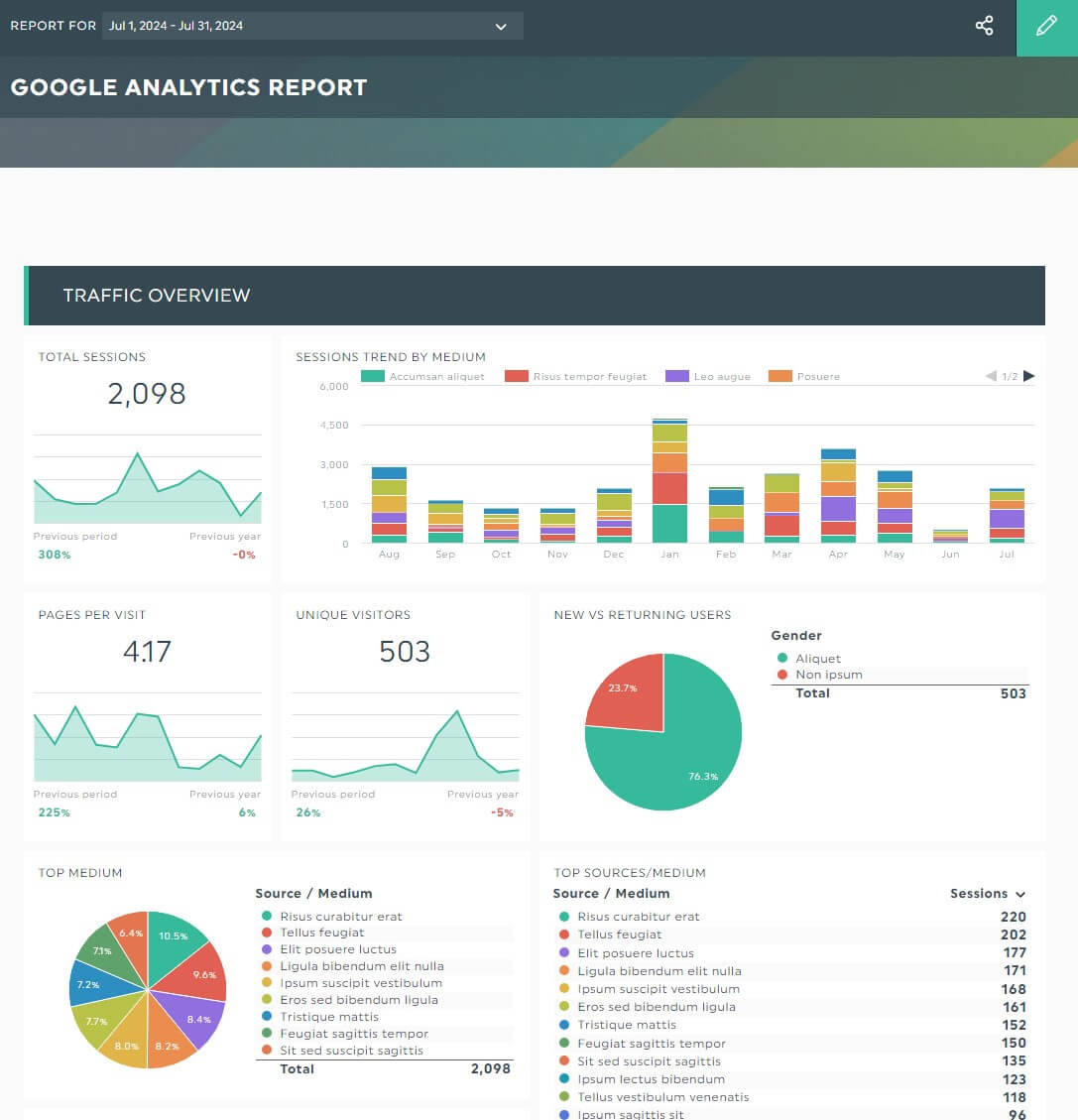
Grab this free omnichannel report with your own data!
Customize your omnichannel marketing dashboard.
Change the colors.
Upload your company's logo.
Or add your recommendations directly within the report.
For example, if you want to suggest combining SEO with paid ads in your omnichannel strategy. Click Static Widget > Comment to make your case.
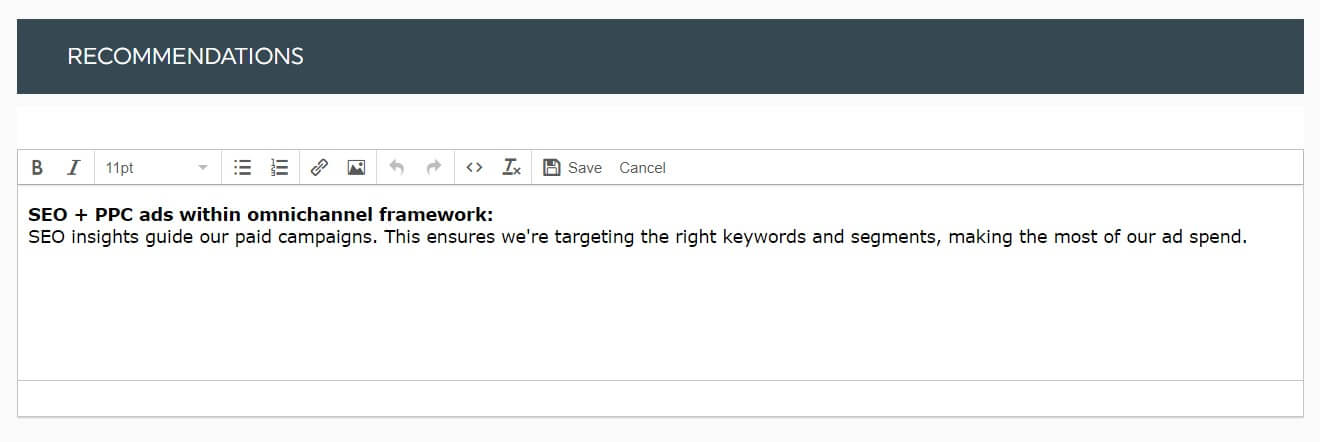
If you're preparing the report for a client, opt for our white-label and custom options. Here, you can use the client's domain name and custom email address and access 8+ beautiful color themes.
Finally, schedule an automatic email dispatch to all stakeholders:
- Hover to the Sharing Options icon on the top right
- Click Share by Email
- Set the dashboard period and frequency
- Add an optional note (e.g., briefly explain what your analysis covers)
- Click Schedule
This email dispatch sends your report according to your preferred schedule automatically.
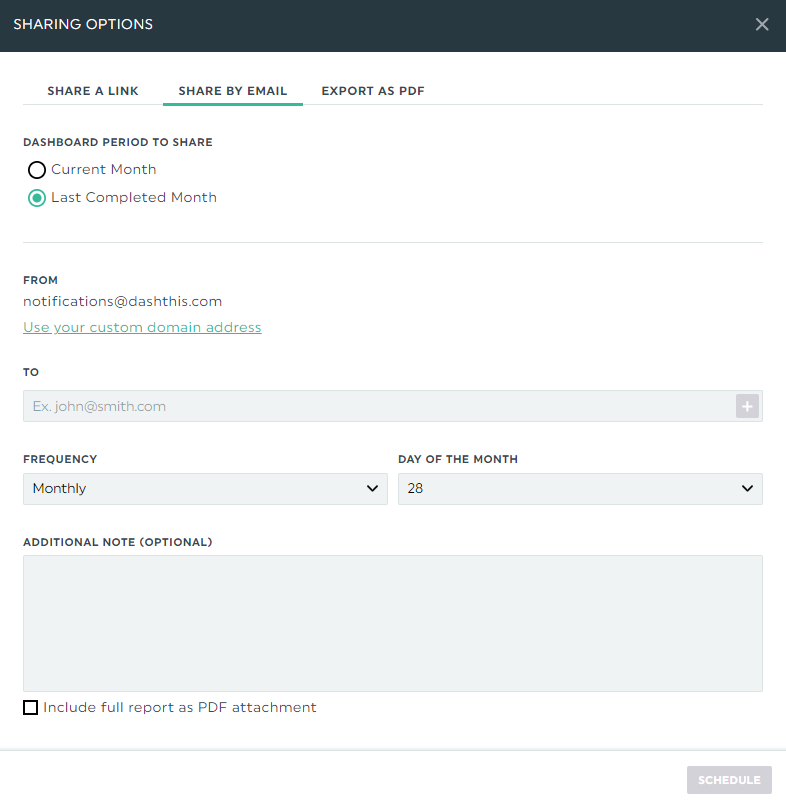
Or share the report via a URL link.
Both options let you view results in real-time.
Start your free 15-day trial to automate your omnichannel reporting today.
Automate Your Omnichannel Reporting on DashThis Today!
Start with the shared KPIs above as you fully integrate your omnichannel efforts as a cross-functional team. It’ll align every stakeholder on common goals.
And while you’re at it, consider using DashThis. It’s the easiest reporting tool that gathers data across multiple marketing platforms into one beautiful report, automatically.
Get a complete picture of the customer journey in a single interface. Start your free 15-day trial to automate your omnichannel reporting today.
Start tracking your most important omnichannel metrics today!
Read More
Don’t miss out!
Automate your reports!
Bring all your marketing data into one automated report.
Try dashthis for free

